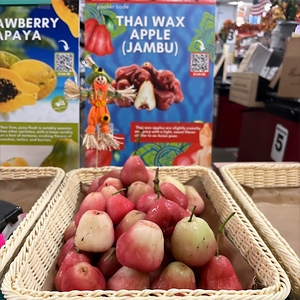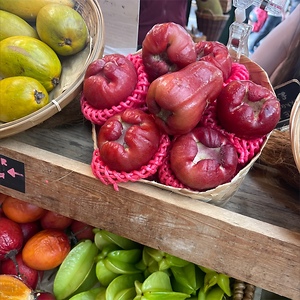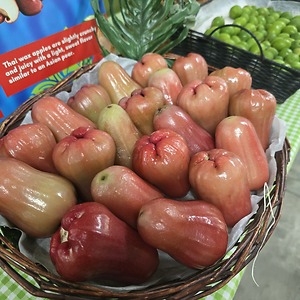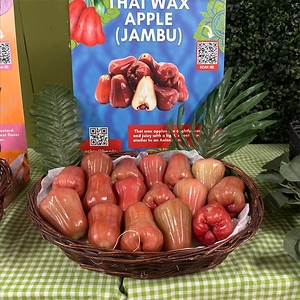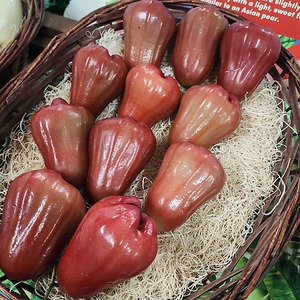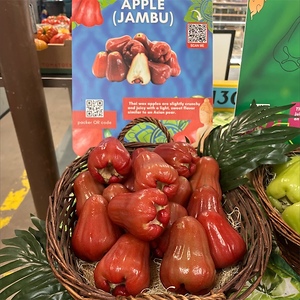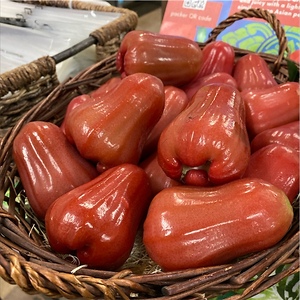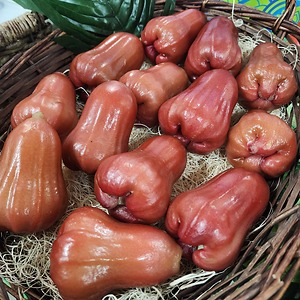

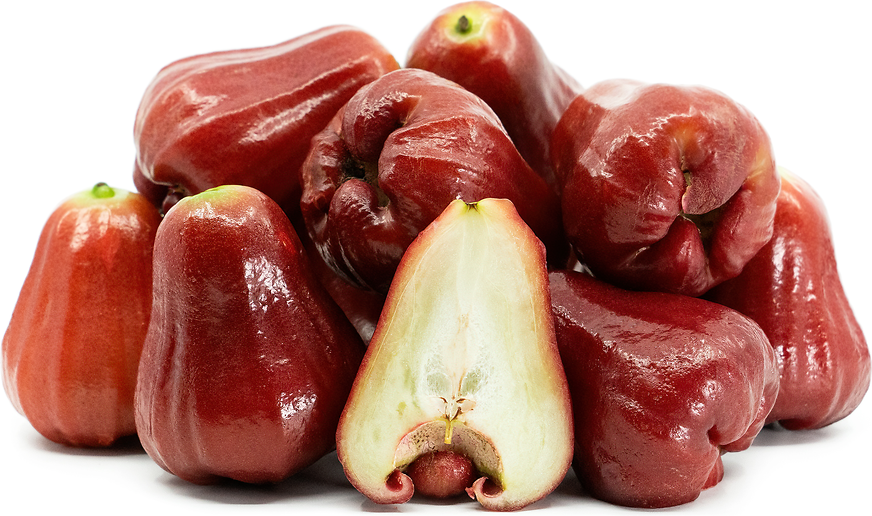
Thai Wax Apple
Estimated Inventory, lb : 0
This item was last sold on : 10/02/24
Description/Taste
Thai Wax apples are a small to medium-sized fruit that measures about 3.5 to 6 centimeters long and 4.5 to 5.5 centimeters wide. These fruits have an exaggerated bell pepper-like shape, with a broad top that tapers to a rounded bottom. They have thin, waxy skin that can be ruby red, green, purple, crimson, deep purple, black, or white. Thai Wax apples have faint ridged lines that run lengthwise from top to bottom. These ridges converge at the top, forming a puckered indentation. Thai Wax apples have a yellow-white or blush pink, spongy flesh that can range from dry and mealy to juicy, succulent, and refreshing. This flesh is typically crunchy and crispy to the taste, encasing a large seed cavity in the center that may contain 1 or 2 large dark brown seeds that are 5 to 8 millimeters wide. Thai Wax apples have a rose-scented aroma and a subtly acidic flavor, accompanied by a lightly sweet taste reminiscent of an Asian pear.
Seasons/Availability
Thai Wax apples are available at different times depending on the region they’re grown in. In Ceylon, they ripen in the spring, while in Java, they are available in the summer.
Current Facts
Thai Wax apples are botanically classified as Syzygium samarangense and belong to the Myrtaceae family, which is made up of approximately 3,300 species including guava, allspice, cloves, and Surinam cherries. Thai Wax apples are referred to as Java apples, Rose apples, Wax jambu, Water apples, and Chom phuu in Thailand, Lian wu in Chinese, and pomme d’eau de Formosein in French. Despite their name, Thai Wax apples only resemble an apple in color and skin texture and are actually a berry. They grow on trees that may reach 5 to 15 meters tall and are often used as an ornamental because of the fragrant flowers they bloom. These trees are also valued for their branches, bark, and wood, which can be crafted into hoops, baskets, furniture, instruments, boats, and brown dyes. Thai Wax apples give the tree their culinary purpose, as they can produce up to 700 fruits in one harvest.
Nutritional Value
Thai Wax apples are a source of vitamin C, encouraging immune health, collagen production, iron absorption, and infection defense as well as discouraging inflammation, UV damage, anxiety, oxidative stress, and free radical cell damage. These fruits also provide the body with fiber to promote digestion, gut health, satiety, blood sugar and pressure control, cholesterol reduction, nutrient absorption, and reducing the risk of hemorrhoids and diverticulosis. Thai Wax apples contain calcium and potassium, nutrients that support bone formation and density, muscle and nerve function, blood clotting, hormone and enzyme regulation, cardiac function, electrolyte balance, and kidney stone prevention. These fruits also have carotene to aid in cholesterol management, calcium absorption, eye health, and cognitive function. Thai Wax apples have many medicinal uses in various countries. In Taiwan, their flowers are utilized for treating fever while in India they serve as a diuretic and tonic for brain and liver health. Decoctions of the bark from their trees are believed to alleviate asthma, bronchitis, hoarseness, and epilepsy.
Applications
Thai Wax apples are suitable for both raw and cooked applications but they are most commonly enjoyed fresh, with the core and seeds removed, as the seeds may be unhealthy to consume. When eaten raw, they can be served with salt or sugar for added flavor or sliced up for salads, fruit bowls, and mixed drinks. These fruits are frequently sautéed or preserved for sauces and jams, or used as a topping for ice cream, pancakes, and French toast. They’re often stewed with traditional apples to create a medley that can be turned into applesauce or syrup for cocktails. Thai Wax apples are used in a Southeast Asian dish called rojak, a mix of pineapples, unripe mangoes, jicama, cucumber, prawn paste, and a spicy dressing of ground chili, peanuts, and palm sugar. They may be hollowed out into a cup-like shape that can be filled rice and meat and topped with a tomato and minced garlic sauce. Thai Wax apples pair well with onions, garlic, chilies, mint, lemon, fennel, cinnamon, sharp cheeses, and greens such as romaine and spinach. They will keep for a couple of days when stored in a cool, dry, and well-ventilated place or longer when refrigerated.
Ethnic/Cultural Info
Chambakka Achar is one of the most famous recipes that Thai Wax apples are used in. This is a traditional South Indian recipe made by pickling these fruits with ginger, garlic, chili powder, mustard seeds, green chilis, and fenugreek powder. These tangy pickles are commonly enjoyed in the summertime at family gatherings. They can be paired with steamed rice or spread on Indian flatbreads like parathas or rotis. Chambakka Achar is enjoyed in Kerala, a state on the Malabar Coast of India along the Arabian Sea.
Geography/History
Thai Wax apples are native to the Malay Peninsula and the Amman, Andaman, and Nicobar Islands. They grow in tropical and subtropical climates with full sun exposure and temperatures of 18 degrees Celcius. Despite their name, Thai Wax apples are not native to Thailand but have become naturalized there as well as in Bangladesh, Taiwan, the Philippines, India, Malaysia, Samoa, Indonesia, Vietnam, Cambodia, India, Zanzibar, and the Tanzanian Island of Pemba. These fruits were introduced to Jamaica in the early 20th century and then made their way to Suriname, Israel, and the islands of Curacao, Aruba, and Bonaire. Thai Wax apples grow on wild trees in the coastal forests of Southeast Asia and are also used as an ornamental in public and private settings throughout tropical climates. In Southeast Asia, these fruits may be sold in street markets and larger stores. They are produced commercially, particularly in Hong Kong, Singapore, China, Thailand, Malaysia, and Taiwan. Outside of these regions, Thai Wax apples are more likely to be purchased from specialty stores and farmers’ markets with a special emphasis in Southeast Asia.
Recipe Ideas
Recipes that include Thai Wax Apple. One
| My Rustic Bajan Garden |
|
Malay Apple Preserves |
| The Baker Within |
|
Otaheite Apple Tart |
| Daily Food Porn |
|
Cinnamon + Jamalac Upside-down |







